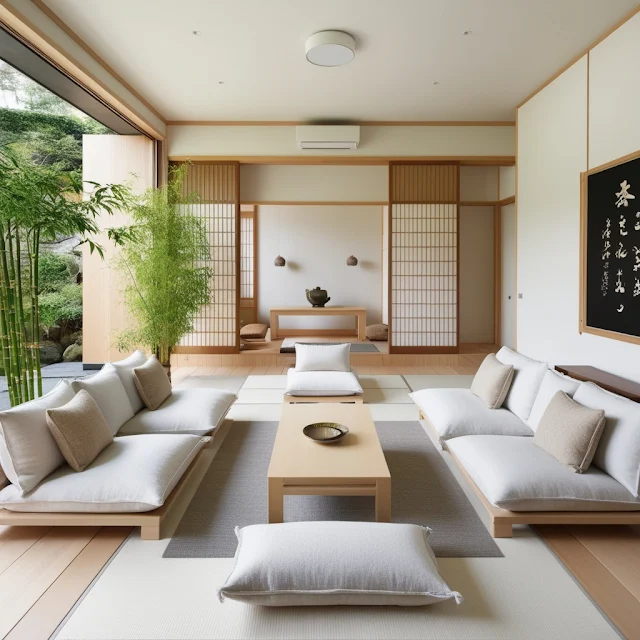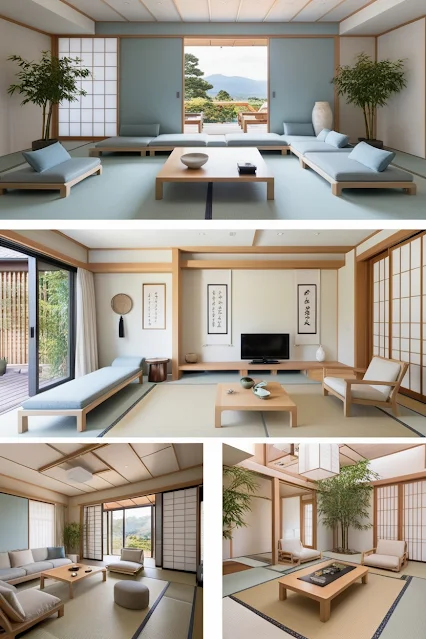Creating a modern and elegant Japanese living room involves blending traditional elements with contemporary design to achieve a space that is both serene and stylish. Here are some key details to consider when designing your own Japanese-inspired living room.
1. Opt for Low-Profile Furniture
Japanese living rooms often feature low sofas, tables, and seating arrangements, which promote a sense of intimacy and connection to the earth. Opt for furniture with simple, straight lines and minimal ornamentation to maintain a clean, uncluttered look.
2. Choose a Neutral Color Palette
A calming color palette of soft whites, beiges, and light grays forms the foundation of a modern Japanese living room. These neutral tones create a serene atmosphere and provide a backdrop that highlights the natural beauty of wood and other materials.
3. Incorporate Natural Materials
Light-colored woods such as birch, bamboo, and maple are essential in Japanese design. Use these woods for flooring, furniture, and decorative elements to bring warmth and natural beauty into the space. Adding traditional tatami mats can enhance the authentic feel.
4. Embrace Textiles
Natural fabrics like cotton, linen, and wool are perfect for cushions, throws, and curtains. These materials add softness and texture while keeping the overall design minimalist and elegant.
5. Maintain an Open and Airy Layout
An open floor plan is key to achieving a spacious and airy feel. Arrange furniture to maximize space and flow, allowing for easy movement and a sense of openness. Sliding doors or shoji screens can be used to separate areas while maintaining flexibility and light flow.
6. Maximize Natural Light and Views
Large windows are a staple of modern Japanese living rooms, bringing in abundant natural light and connecting the indoor space with the outdoors. Design your room to offer views of gardens or natural landscapes, enhancing the tranquility of the space.
7. Add Greenery
Incorporate greenery with bonsai trees, bamboo plants, or other indoor plants. These elements bring life and nature into the room, creating a calming environment.
8. Use Elegant Decor
Choose traditional Japanese artwork, calligraphy, or wall hangings with subtle, elegant designs to add cultural depth. Display elegant ceramics, vases, and pottery in muted tones to enhance the minimalist aesthetic.
9. Soft, Ambient Lighting
Lighting plays a crucial role in creating a warm and inviting atmosphere. Use soft, ambient lighting with paper lanterns or minimalist pendant lights to achieve a cozy yet modern look.
10. Integrate Traditional Textiles and Patterns
Incorporate floor cushions with traditional patterns or textures to add visual interest and comfort. Simple, understated rugs or tatami mats can also enhance the room's traditional feel.
11. Choose Simple Curtains and Blinds
For window treatments, opt for simple, neutral-colored curtains or bamboo blinds. These choices maintain the room's minimalist aesthetic while providing privacy and light control.
12. Functional Furniture
Select furniture that serves multiple functions, such as storage ottomans or convertible tables. This approach helps maintain a clean and clutter-free space, emphasizing functionality and simplicity.
13. Symmetry and Balance
Arrange furniture and decor symmetrically to create a sense of balance and harmony. This principle is central to Japanese design, fostering a tranquil and orderly environment.
14. Traditional Touches
Incorporate cultural elements like a traditional Japanese tea set displayed on a low table. These touches add authenticity and personal connection to the space.
By focusing on these key elements, you can create a modern and elegant Japanese living room that is both beautiful and functional. This design approach not only enhances the aesthetic appeal of your home but also promotes a sense of peace and harmony, making it a perfect sanctuary for relaxation and contemplation.









Comments
Post a Comment